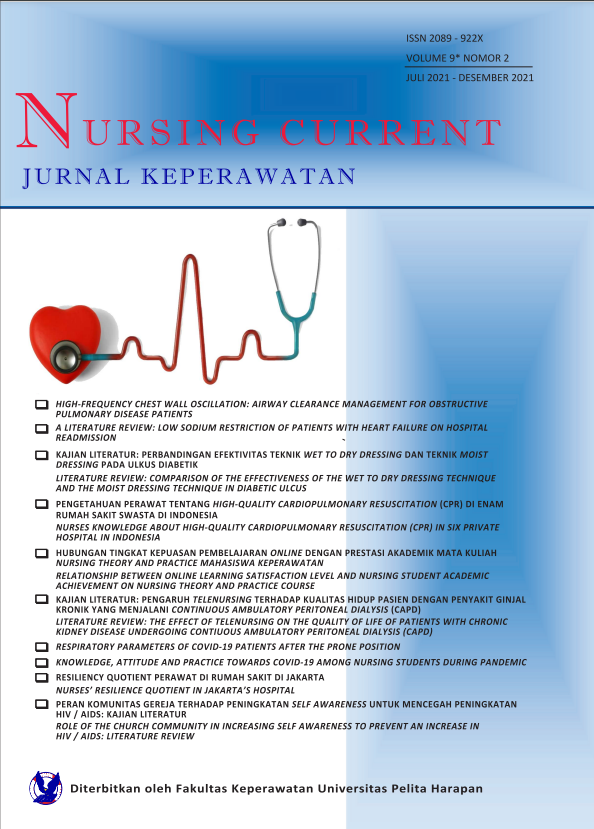RESILIENCY QUOTIENT PERAWAT DI RUMAH SAKIT DI JAKARTA [NURSES’ RESILIENCE QUOTIENT IN JAKARTA’S HOSPITAL]
DOI:
https://doi.org/10.19166/nc.v9i2.4978Keywords:
Burnout, Perawat, Resiliensi, Stress KerjaAbstract
BAHASA INDONESIA Perawat merupakan kelompok tenaga kesehatan yang berisiko mengalami tekanan kerja, apabila tidak dapat diadaptasi akan menimbulkan stress kerja dan jika berlangsung lama dengan intensitas yang tinggi dapat berujung pada burnout. Oleh sebab itu, perawat membutuhkan resiliensi untuk dapat bertahan dalam menghadapi berbagai masalah dan tuntutan pekerjaan di rumah sakit. Penelitian tentang resiliensi pada perawat di Indonesia masih sangat sedikit, begitu juga di satu rumah sakit swasta di Jakarta penelitian mengenai resiliensi belum pernah dilakukan. Penelitian ini bertujuan untuk mengetahui gambaran resiliency quotient pada perawat di rumah sakit swasta di Jakarta. Penelitian ini adalah penelitian kuantitatif dengan menggunakan desain penelitian deskriptif. Populasi dalam penelitian ini adalah perawat di satu rumah sakit swasta di Indonesia. Sampel penelitian berjumlah 156 perawat dengan menggunakan metode Convenience Sampling. Pengambilan data menggunakan kuesioner Resiliency Quotient (RQ) Russell dan Russell (2007) dengan jumlah pertanyaan sebanyak 32 item (Cronbach’s Alpha 0,951). Analisis data menggunakan teknik analisis deskriptif. Hasil penelitian ini menunjukan bahwa mayoritas perawat masuk dalam kategori resilient yaitu sebanyak 137 perawat (87,82%),18 perawat (11,54%) sangat resilient, dan satu perawat (0,64%) sedikit resilient. Pada penelitian selanjutnya diharapkan untuk menggali lebih dalam faktor-faktor yang memengaruhi resiliensi pada perawat.
BAHASA INGGRIS Nurses are a group of healthcare workers who are at risk of experiencing work pressure which mightl cause job stress and in turn might lead to burnout. Therefore, nurses need to be resilient to be able to face various problems and work demands in the hospital. Research on resiliency of nurses in Jakarta is still insufficient, as is in a private hospital in western Indonesia where research on resiliency has never been done. Purpose: This study aimed to describe nurse’s resiliency quotient. This was a descriptive quantitative study. The population was nurses in a private hospital in western Indonesia, obtaining 156 respondents. The instrument used was Resiliency Quotient (RQ) questionnaire by Russell and Russell (2007) with 32 questions. The result showed that the majority (87,82%) of nurses were resilient, 18 (11.54%) nurses were very resilient, and only 1 (0.64%) who was slightly resilient. It is expected that the next study will explore in depth about factors contributing to nurses’ resiliency.
References
Ardiyanto, R. (2018). Hubungan Antara Resiliensi Dengan Stres Kerja (Master’s thesis). Universitas Muhammadiyah Surakarta. http://eprints.ums.ac.id/id/eprint/67111
Asih, O. R., Fahmy, R., Novrianda, D., Lucida, H., Priscilla, V., & Putri, Z. N. (2019). Cross Sectional: Dukungan Sosial dan Resiliensi Perawat. Jurnal Ilmiah Universitas Batanghari Jambi, 19(2): 421-425. https://doi.org/10.33087/jiubj.v19i2.674
Begley, S., & Davidson, R. J. (2012). The emotional life of your brain. New York: Hudson Street.
Hart, P. L., Brannan, J. D., & DeChesnay, M. (2014). Resilience in nurses: An integrative review. Journal of Nursing Management, 22, 720-734. https://doi.org/10.1111/j.1365-2834.2012.01485.x
Haryanti, Aini, F., & Purwaningsih, P. (2013). Hubungan Antara Beban Kerja Perawat Dengan Stress Kerja Perawat di Instalasi Gawat Darurat RSUD Semarang. Jurnal manajemen keperawatan,1(1), 48-56. https://jurnal.unimus.ac.id/index.php/JMK/article/view/949/1001
Hoopes, L. L. (2012). Developing Personal Resilience In Organization Settings. Resilliance Alliance. http://resiliencealliance.com/wp-content/uploads/4-Developing_Personal_Resilience_in_Organizational_Settings_by_Linda_L. Hoopes_page_79-99.pdf
Lee, Y. S. C., Suchday, S., & Wylie-Rosett, J. (2012). Perceived Social Support, Coping Styles, and Chinese Immigrants’ Cardiovascular Responses to Stress. International Journal of Behavioral Medicine, 19(2), 174-185. https://doi.org/10.1007/s12529-011-9156-7
Kim, M., & Windsor, C. (2015). Resilience and work-life balance in first-line nurse manager. Asian Nursing Research, 9(1), 21-27. https://doi.org/10.1016/j.anr.2014.09.003
Mariani, B. U. (2013). Faktor-Faktor Personal Sebagai Prediktor Terhadap Resiliensi Perawat di Rumah Sakit Penyakit Infeksi Prof. Dr. Sulianti Saroso. The Indonesian Journal of Infectious Disease, 1(1), 14-21. https://doi.org/10.32667/ijid.v1i01.3
Padesky, C. A., & Mooney, K. A. (2012). Strengths-Behavioural Therapy: A Four-Step Model to Build resilience. Clinical Psyhcology & Psychothrapy, 19(4), 283-290. https://doi.org/10.1002/cpp.1795
Pertiwi, M. (2011) Dimensi Religiusitas Dan Resiliensi Pada Residen Narkoba di BNN LIDO (Master’s thesis). UIN SYARIF HIDAYATULLAH JAKARTA. http://repository.uinjkt.ac.id/dspace/handle/123456789/4779
Russell, J., & Russell, L. (2007). Measuring Employee Resilience. New York: Russell Consulting. Inc.
Sullivan, P., & Bissett, K. (2012). Grace Under Fire: Surviving and Thriving in Nursing By Cultivating Resilience. American Nurse Today, 7(12). https://www.americannursetoday.com/grace-under-fire-surviving-and-thriving-innursing-by-cultivating-resilience/
Yu, F., Raphael, D., Mackay, L., Smith, M., & King, A. (2019) Personal and work-related factors associated with nurse resilience: A systematic review. International Journal of Nursing Studies, 93, 129-140. https://doi.org/10.1016/j.ijnurstu.2019.02.014
Zander, M., Hutton, A., & King, L. (2010). Coping and resilience factors in pediatric oncology nurses. Journal of Pediatric Oncology Nursing, 27(2), 94-108. https://doi.org/10.1177/1043454209350154
Downloads
Published
How to Cite
Issue
Section
License
Authors who publish with this journal agree to the following terms:
1) Authors retain copyright and grant the journal right of first publication with the work simultaneously licensed under a Creative Commons Attribution License (CC-BY-SA 4.0) that allows others to share the work with an acknowledgement of the work's authorship and initial publication in this journal.
2) Authors are able to enter into separate, additional contractual arrangements for the non-exclusive distribution of the journal's published version of the work (e.g., post it to an institutional repository or publish it in a book), with an acknowledgement of its initial publication in this journal.
3) Authors are permitted and encouraged to post their work online (e.g., in institutional repositories or on their website). The final published PDF should be used and bibliographic details that credit the publication in this journal should be included.

This work is licensed under a Creative Commons Attribution-ShareAlike 4.0 International License.






